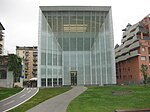Rai Südtirol (radio station)
1960 establishments in ItalyEuropean radio station stubsGerman-language mass media in South TyrolGerman-language radio stationsMass media in Bolzano ... and 6 more
Mass media in Italy stubsRAI radio stationsRadio stations established in 1960Radio stations in ItalyWikipedia external links cleanup from November 2020Wikipedia spam cleanup from November 2020

Rai Südtirol is a German language radio station produced by the Italian public-service broadcasting network RAI from its studios in Bolzano. The station programming is aimed to the German-speaking listeners in South Tyrol. Transmissions began in 1960. The schedules also include a number of programmes in Ladin language. From 22 till 06 Rai Radio 3 programming is being broadcast.
Excerpt from the Wikipedia article Rai Südtirol (radio station) (License: CC BY-SA 3.0, Authors, Images).Rai Südtirol (radio station)
Piazza Giuseppe Mazzini - Giuseppe-Mazzini-Platz, Bolzano - Bozen Hof
Geographical coordinates (GPS) Address Website Nearby Places Show on map
Geographical coordinates (GPS)
| Latitude | Longitude |
|---|---|
| N 46.5014 ° | E 11.3388 ° |
Address
Rai Alto Adige (Rai Bolzano - Rai Bozen)
Piazza Giuseppe Mazzini - Giuseppe-Mazzini-Platz
39100 Bolzano - Bozen, Hof
Trentino-Alto Adige/Südtirol, Italy
Open on Google Maps









